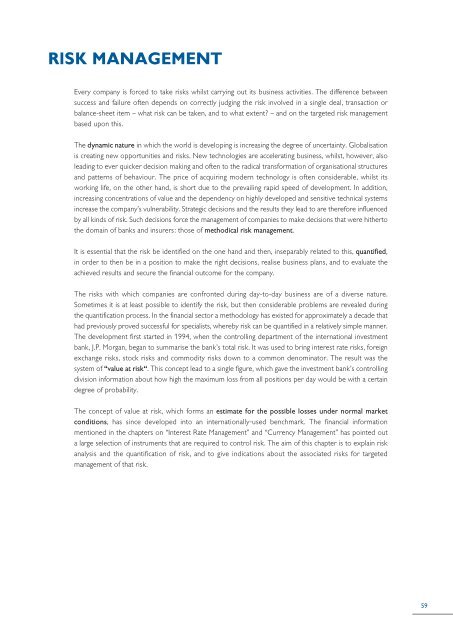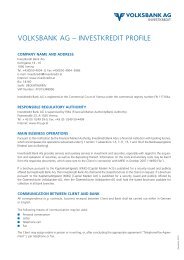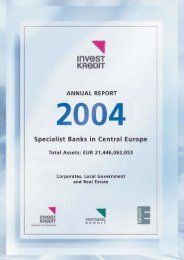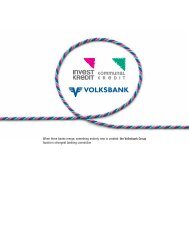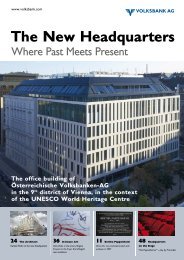instruments in interest-rate, currency and ... - Volksbank AG
instruments in interest-rate, currency and ... - Volksbank AG
instruments in interest-rate, currency and ... - Volksbank AG
Create successful ePaper yourself
Turn your PDF publications into a flip-book with our unique Google optimized e-Paper software.
RISK MAN<strong>AG</strong>EMENTEvery company is forced to take risks whilst carry<strong>in</strong>g out its bus<strong>in</strong>ess activities. The difference betweensuccess <strong>and</strong> failure often depends on correctly judg<strong>in</strong>g the risk <strong>in</strong>volved <strong>in</strong> a s<strong>in</strong>gle deal, transaction orbalance-sheet item – what risk can be taken, <strong>and</strong> to what extent? – <strong>and</strong> on the targeted risk managementbased upon this.The dynamic nature <strong>in</strong> which the world is develop<strong>in</strong>g is <strong>in</strong>creas<strong>in</strong>g the degree of uncerta<strong>in</strong>ty. Globalisationis creat<strong>in</strong>g new opportunities <strong>and</strong> risks. New technologies are accelerat<strong>in</strong>g bus<strong>in</strong>ess, whilst, however, alsolead<strong>in</strong>g to ever quicker decision mak<strong>in</strong>g <strong>and</strong> often to the radical transformation of organisational structures<strong>and</strong> patterns of behaviour. The price of acquir<strong>in</strong>g modern technology is often considerable, whilst itswork<strong>in</strong>g life, on the other h<strong>and</strong>, is short due to the prevail<strong>in</strong>g rapid speed of development. In addition,<strong>in</strong>creas<strong>in</strong>g concentrations of value <strong>and</strong> the dependency on highly developed <strong>and</strong> sensitive technical systems<strong>in</strong>crease the company’s vulnerability. St<strong>rate</strong>gic decisions <strong>and</strong> the results they lead to are therefore <strong>in</strong>fluencedby all k<strong>in</strong>ds of risk. Such decisions force the management of companies to make decisions that were hithertothe doma<strong>in</strong> of banks <strong>and</strong> <strong>in</strong>surers: those of methodical risk management.It is essential that the risk be identified on the one h<strong>and</strong> <strong>and</strong> then, <strong>in</strong>separably related to this, quantified,<strong>in</strong> order to then be <strong>in</strong> a position to make the right decisions, realise bus<strong>in</strong>ess plans, <strong>and</strong> to evaluate theachieved results <strong>and</strong> secure the f<strong>in</strong>ancial outcome for the company.The risks with which companies are confronted dur<strong>in</strong>g day-to-day bus<strong>in</strong>ess are of a diverse nature.Sometimes it is at least possible to identify the risk, but then considerable problems are revealed dur<strong>in</strong>gthe quantification process. In the f<strong>in</strong>ancial sector a methodology has existed for approximately a decade thathad previously proved successful for specialists, whereby risk can be quantified <strong>in</strong> a relatively simple manner.The development first started <strong>in</strong> 1994, when the controll<strong>in</strong>g department of the <strong>in</strong>ternational <strong>in</strong>vestmentbank, J.P. Morgan, began to summarise the bank’s total risk. It was used to br<strong>in</strong>g <strong>in</strong>terest <strong>rate</strong> risks, foreignexchange risks, stock risks <strong>and</strong> commodity risks down to a common denom<strong>in</strong>ator. The result was thesystem of “value at risk“. This concept lead to a s<strong>in</strong>gle figure, which gave the <strong>in</strong>vestment bank’s controll<strong>in</strong>gdivision <strong>in</strong>formation about how high the maximum loss from all positions per day would be with a certa<strong>in</strong>degree of probability.The concept of value at risk, which forms an estimate for the possible losses under normal marketconditions, has s<strong>in</strong>ce developed <strong>in</strong>to an <strong>in</strong>ternationally-used benchmark. The f<strong>in</strong>ancial <strong>in</strong>formationmentioned <strong>in</strong> the chapters on “Interest Rate Management” <strong>and</strong> “Currency Management” has po<strong>in</strong>ted outa large selection of <strong><strong>in</strong>struments</strong> that are required to control risk. The aim of this chapter is to expla<strong>in</strong> riskanalysis <strong>and</strong> the quantification of risk, <strong>and</strong> to give <strong>in</strong>dications about the associated risks for targetedmanagement of that risk.59


